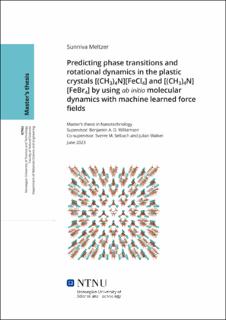| dc.contributor.advisor | Williamson, Benjamin A. D. | |
| dc.contributor.advisor | Selbach, Sverre Magnus | |
| dc.contributor.advisor | Walker, Julian | |
| dc.contributor.author | Meltzer, Sunniva | |
| dc.date.accessioned | 2023-09-19T17:19:39Z | |
| dc.date.available | 2023-09-19T17:19:39Z | |
| dc.date.issued | 2023 | |
| dc.identifier | no.ntnu:inspera:151103120:34113931 | |
| dc.identifier.uri | https://hdl.handle.net/11250/3090574 | |
| dc.description.abstract | Plastiske krystaller er en ny materialklasse med glimrende piezoelektriske og ferroelektriske egenskaper, i tillegg til å være myke og fleksible grunnet rotasjonsfriheten til molekylene. Dette gjør dem til lovende kandidater for å erstatte bly-baserte ferroelektriske materialer i metall-oksid-keramikkbransjen, som et bærekraftig, resirkulerbart og billig alternativ. I tillegg kan plastiske krystaller potensielt brukes i applikasjoner som termisk energilagring og til å forbedre den ioniske ledningsevnen i Li-ionebatterier. Imidlertid er plastiske krystaller dårlig forstått på et mikroskopisk nivå, og de er vanskelige å modellere siden rotasjonsfriheten til molekylene gjør dem svært uordnede.
Målet med denne oppgaven var å forutsi faseovergangene og studere rotasjonsdynamikken i de plastiske krystallene tetrametylammonium-klorotetraferrat ([(CH3)4N][FeCl4]) og tetrametylammonium-bromotetraferrat ([(CH3)4N][FeBr4]) ved å bruke ab initio molekylærdynamikksimuleringer med maskinlærte kraftfelt. Faseovergangene ble studert ved å undersøke endringene i gitter-parametere, enhetscellevolum samt XRD-spektrene til de to forbindelsene ved oppvarming fra 200 K til 400 K og tilbake igjen, og rotasjonsdynamikken ble studert ved å analysere autokorrelasjonen i hver krystall.
Resultatene viste at oppvarmingsprosessen induserte en faseovergang fra Amm2-fasen til den plastiske mesofasen for [(CH3)4N][FeCl4]-krystallen, mens [(CH3)4N][FeBr4]-krystallen ikke så ut til å nå denne plastiske mesofasen. Dette skyldes antageligvis sterisk hindring av [(CH3)4N]-molekylene i [(CH3)4N][FeBr4]-krystallen, og at overgangen til mesofasen i [(CH3)4N][FeBr4] krever høyere temperaturer enn i [(CH3)4N][FeCl4]. Dette stemte bra overens med analysen av rotasjonsdynamikken i de to krystallene, hvor resultatene viste at det var mer rotasjonsfrihet i [(CH3)4N][FeCl4]-krystallen enn i [(CH3)4N][FeBr4]-krystallen, og at rotasjonsfriheten økte med økende temperatur. | |
| dc.description.abstract | Plastic crystals are a novel class of materials that exhibit excellent piezoelectric and ferroelectric properties, in addition to being soft and flexible due to rotational freedom of the molecules. This makes them promising candidates for replacing lead-based ferroelectrics in the metal oxide ceramics industry, being a sustainable, recyclable and cheap alternative. In addition, plastic crystals can potentially be used for thermal energy storage applications and to improve the ionic conductivity in Li-ion batteries. However, plastic crystals are poorly understood on a microscopic level, and are challenging to model since the rotational freedom of the molecules makes them highly disordered.
The aim of this thesis was to predict the phase transitions and study the rotational dynamics in the plastic crystals tetramethylammonium irontetrachloride ([(CH3)4N][FeCl4]) and tetramethylammonium irontetrabromide ([(CH3)4N][FeBr4]) through ab initio molecular dynamics simulations using machine learned force fields. The phase transitions were studied by investigating the change in lattice parameters, unit cell volume and XRD spectra for the two compounds upon heating and cooling from 200 K to 400 K and back again, and the rotational dynamics were studied by analysing the autocorrelation within each structure.
The results showed that the heating process induced a phase transition from the Amm2 phase to the plastic mesophase for the [(CH3)4N][FeCl4] crystal, while the [(CH3)4N][FeBr4] crystal did not seem to reach the high temperature plastic mesophase. This was likely due to steric hindrance of the [(CH3)4N] molecules in the [(CH3)4N][FeBr4] crystal, and that the transition to the mesophase in [(CH3)4N][FeBr4] requires higher temperatures than in [(CH3)4N][FeCl4]. These findings agreed well with the analysis of the rotational dynamics of the two crystals, where the results demonstrated that there was more rotational freedom within the [(CH3)4N][FeCl4] crystal than within the [(CH3)4N][FeBr4] crystal and that the rotational freedom of the molecules increased with increasing temperature. | |
| dc.language | eng | |
| dc.publisher | NTNU | |
| dc.title | Predicting phase transitions and rotational dynamics in the plastic crystals [(CH3)4N][FeCl4] and [(CH3)4N] [FeBr4] by using ab initio molecular dynamics with machine learned force fields | |
| dc.type | Master thesis | |
